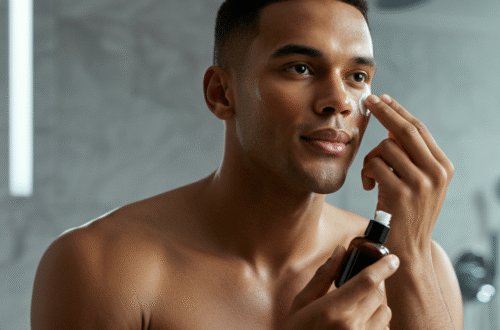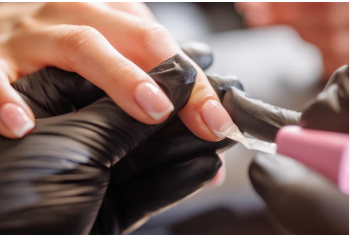Have you ever walked out of a nail salon with a fresh manicure, feeling like you can take on the world?There’s a special kind of confidence that comes with perfectly polished nails. If you’re a fan of long-lasting, durable manicures, you’ve likely heard the buzz around SNS. But what exactly are SNS fingernails, and are they the right choice for you? This guide will walk you through everything, from the application process to the benefits and potential downsides, helping you make an informed decision for your next salon visit.
What Exactly Are SNS Fingernails?
SNS stands for Signature Nail Systems, a brand name that has become synonymous with a specific type of manicure: the dip powder manicure. Unlike traditional acrylics that use a strong-smelling liquid monomer or gel polishes that need curing under a UV light, SNS involves dipping your nails into a finely milled powder.
The process starts with a base coat applied to the nail. Then, the nail is dipped into a jar of colored powder. This step is repeated a few times to build up the desired thickness and color intensity. A sealant is applied to harden the powder, and the process is finished with a glossy top coat. The result is a lightweight, strong, and durable manicure that can last for weeks without chipping. Many people love SNS fingernails because they feel more natural than bulky acrylics and offer incredible strength.
Key Takeaways
- SNS is a Brand: SNS stands for Signature Nail Systems, a popular brand of dip powder.
- No UV Light Needed: The process uses a series of liquids and powders that air dry, eliminating the need for UV or LED lamps.
- Durable & Long-Lasting: SNS manicures are known for their strength and can last three weeks or more without chipping.
- Odor-Free Application: The application process is virtually odorless, which is a major plus compared to the strong fumes of acrylic monomer.
- Removal is Key: Proper removal by soaking is crucial to prevent damage to your natural nails.
The Step-by-Step SNS Application Process
Getting SNS fingernails is a unique and satisfying process. If you’re curious about what happens during your appointment, here is a breakdown of the typical steps a nail technician will follow.
First, your nails are prepped. This is a crucial step for any long-lasting manicure. Your technician will push back your cuticles, gently buff the surface of your nails to remove any shine, and shape them to your desired length and style. They will also dehydrate the nail plate to ensure the product adheres properly.
Next, a thin layer of base coat is brushed onto one nail. This liquid acts as the adhesive for the powder. Immediately after, your finger is dipped into the jar of colored powder at a 45-degree angle. The excess powder is tapped off. This process is repeated for each nail. Most manicures require two or three dips to achieve full, opaque color and strength. After the color layers are complete, a special activator liquid is brushed on. This liquid chemically reacts with the powder and base coat, hardening it instantly without any need for a lamp. Finally, your nails are buffed smooth, and a shiny top coat is applied to seal everything in, giving you that brilliant, glossy finish.
SNS vs. Gel vs. Acrylics: What’s the Difference?
Choosing a manicure type can be confusing with so many options available. SNS, gel, and acrylics are three of the most popular choices for long-lasting nail enhancements. While they all provide durable and beautiful results, they differ significantly in application, feel, and removal. Understanding these differences can help you pick the perfect one for your lifestyle and nail health goals.
For example, a busy professional might prefer the quick-drying and durable nature of SNS fingernails, while someone who likes to change their nail art frequently might lean towards gel. To make it easier, let’s compare them side-by-side.
|
Feature |
SNS (Dip Powder) |
Gel Manicure |
Traditional Acrylics |
|---|---|---|---|
|
Application |
Dipping nails in powder after a base coat is applied. |
Brushing on polish layers that are cured under a UV/LED lamp. |
Mixing a liquid (monomer) and powder (polymer) to sculpt a nail. |
|
Durability |
Very durable; lasts 3-4 weeks. Resistant to chips and cracks. |
Durable; lasts 2-3 weeks. Can be prone to chipping with heavy use. |
Extremely durable; lasts 3-4 weeks. Very hard and rigid. |
|
Smell |
Odorless application process. |
Odorless. |
Strong chemical odor from the liquid monomer. |
|
Flexibility |
More flexible than acrylics, but less than gel. |
Very flexible, feels like natural nails. |
Very rigid and inflexible. |
|
Removal |
Soaked off with acetone. Can be time-consuming. |
Soaked off with acetone. |
Soaked off with acetone, often with filing. |
|
Nail Health |
Can be gentle if removed correctly. Fortified with vitamins. |
Generally safe, but UV exposure and improper removal can be damaging. |
Can be damaging due to heavy filing and the chemicals used. |
The Pros of Choosing an SNS Manicure
Many people are loyal fans of SNS fingernails, and for good reason. There are several compelling advantages that make this type of manicure a go-to choice.
Unmatched Durability
One of the biggest selling points is strength. SNS creates a hard shell over your natural nails that is incredibly resistant to chips, cracks, and daily wear and tear. For those who are tough on their hands or work in jobs that require a lot of manual labor, an SNS manicure can easily last three weeks or longer while still looking flawless. This longevity means fewer trips to the salon, saving you both time and money.
A More Natural Feel
Despite their strength, SNS fingernnails are surprisingly lightweight. They don’t have the heavy, bulky feeling that is often associated with traditional acrylics. Many users report that SNS feels more like their natural nails, just stronger. This makes them more comfortable for everyday wear.
No UV Light Exposure
Growing concerns about the long-term effects of UV radiation on the skin have made many people wary of gel manicures. SNS manicures air dry and harden with a chemical activator, so no UV or LED lamp is required. This eliminates any risk associated with UV exposure, giving you peace of mind.
An Odor-Free Experience
If you’ve ever been in a salon when acrylics are being applied, you know the powerful chemical smell that fills the air. The SNS application process is virtually odorless, making the salon experience much more pleasant for both you and your nail technician.
The Cons and Considerations for SNS Fingernails
While there are many benefits, it’s also important to be aware of the potential downsides of SNS fingernails before you commit. No manicure is perfect for everyone, and knowing the drawbacks can help you avoid any negative experiences.
The Removal Process Can Be Tricky
Proper removal is non-negotiable for maintaining healthy nails, and this is where SNS can be problematic if done incorrectly. The product needs to be soaked off in acetone for about 15-20 minutes. Some technicians may try to rush this process by prying or filing off the product aggressively, which can peel away layers of your natural nail, leaving them weak, thin, and damaged. It is crucial to insist on a gentle soak-off removal or learn to do it safely at home.
Hygiene Concerns with Community Pots
A significant concern is the hygiene of dipping every client’s finger into the same pot of powder. This practice can potentially spread bacteria and nail infections. To combat this, reputable salons will pour the powder over your nail instead of dipping it directly into the main container. Don’t be afraid to ask your technician about their sanitation practices before starting your service.
Potential for Thick Application
If the technician is not experienced, SNS fingernails can end up looking thick and bulky. The application requires skill to create thin, even layers. A thick application not only looks unnatural but can also feel heavy on the nails. Finding a skilled and experienced technician is key to getting a beautiful result.
Are SNS Fingernails Bad for Your Nails?
This is one of the most common questions people have. The short answer is: no, the product itself is not inherently bad for your nails. Damage from SNS fingernails almost always comes from improper application or, more commonly, improper removal.
When applied correctly over a healthy nail bed, SNS can actually help protect your nails from breaking, allowing them to grow longer and stronger underneath. The formulas often contain vitamins like A, E, D, and B5, plus calcium, which can help nourish the nail. However, the benefits of these vitamins are debated, as nails are made of dead keratin cells and can’t absorb nutrients in the same way skin can.
The real damage occurs when the dip powder is filed down too aggressively during prep or pried off during removal. This strips away the top layers of your nail plate, leading to weakness, brittleness, and sensitivity. To keep your nails healthy, always ensure your manicure is soaked off completely until the product slides off with gentle pushing.
How to Safely Remove SNS at Home
If you want to save money or ensure your nails are treated gently, learning to remove your SNS fingernails at home is a great idea. It requires patience, but it’s the best way to protect your natural nails.
You will need:
- 100% pure acetone
- A coarse nail file
- Cotton balls
- Aluminum foil squares
- A cuticle pusher or orangewood stick
- Nail and cuticle oil
Step 1: File the Top Coat
The shiny top coat is non-porous and acetone-resistant. You must file it off to allow the acetone to penetrate the layers of powder underneath. Use a coarse file to gently but thoroughly file away the entire shiny layer.
Step 2: Soak the Nails
Soak a cotton ball in pure acetone, place it directly on top of your nail, and wrap the entire fingertip tightly with a square of aluminum foil. The foil traps heat and prevents the acetone from evaporating, speeding up the process. Repeat for all ten nails.
Step-3: Wait Patiently
Let your nails soak for at least 15 to 20 minutes. This is a perfect time to catch up on a show or listen to a podcast. Do not peek! Letting the acetone do its work is crucial.
Step 4: Gently Remove the Product
After 15-20 minutes, remove the foil from one finger. The SNS product should look gummy and be lifting off the nail. Use a cuticle pusher to gently scrape the product off. If it doesn’t come off easily, re-wrap the nail and let it soak for another 5 minutes. Never force it!
Step 5: Hydrate and Moisturize
Once all the product is off, your nails and skin will be very dry from the acetone. Wash your hands, and then generously apply a high-quality cuticle oil and hand cream to rehydrate your nails and the surrounding skin.
Cost of SNS Fingernails: What to Expect
The cost of an SNS fingernails manicure can vary widely based on your location, the salon’s reputation, and the experience of the technician. Generally, you can expect to pay anywhere from $35 to $75 for a standard color application.
Prices in major metropolitan areas will typically be on the higher end of that range, while salons in smaller towns may offer more budget-friendly rates. Additional services will also add to the cost. For example, if you want French tips, an ombre effect, or extra length using nail tips, the price will increase. Removal services usually cost an additional $10 to $15, although some salons may include it for free if you are getting a new set applied immediately. While it may be tempting to go for the cheapest option, remember that with nail services, you often get what you pay for in terms of skill and hygiene.
Frequently Asked Questions (FAQ)
Q1: How long do SNS fingernails last?
A: With proper care, SNS fingernails can last anywhere from three to four weeks without chipping. Their durability is one of their main selling points.
Q2: Can you get a fill with SNS?
A: While it’s technically possible, most technicians advise against fills for dip powder. For a clean look and to ensure nail health, it is best to do a full soak-off and apply a fresh set each time.
Q3: Is SNS better than gel?
A: “Better” is subjective and depends on your priorities. SNS is more durable and doesn’t require UV light. Gel is more flexible and can be easier to soak off. If you prioritize strength, SNS is a great choice. If you prefer a more natural, flexible feel, you might prefer gel.
Q4: Does SNS damage your natural nails?
A: The SNS product itself is not damaging. Damage is caused by improper removal, such as aggressive filing or prying the product off. Always insist on a full soak-off to protect your natural nails.
Q5: Can I put regular polish over SNS?
A: Yes! If you get tired of your color before your manicure has grown out, you can absolutely paint over your SNS fingernails with regular nail polish. Just be sure to use a non-acetone remover to take it off, as acetone will dissolve the SNS.
For more style inspiration and beauty tips, you can explore the latest trends on platforms like the truefashionstory.com Blog.
The Final Verdict: Are SNS Fingernails Right for You?
Ultimately, SNS fingernails are an excellent option for anyone seeking a strong, long-lasting, and beautiful manicure. They offer superior durability compared to gel polish and a more lightweight feel than traditional acrylics. The odorless application and lack of UV light exposure are significant health and comfort benefits.
The key to a positive experience lies in finding a skilled technician who prioritizes nail health and sanitation. Be mindful of the salon’s hygiene practices and always ensure your manicure is removed gently with a full soak-off. If you value strength and longevity in a manicure and are prepared for the necessary removal process, then an SNS dip powder manicure is definitely worth a try.





